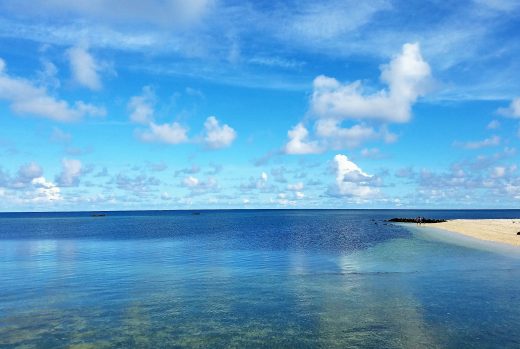Visiting Pag-asa

An abandoned lifeboat on Pag-asa’s powdery white beach.
“If it’s your birthday, they give you two chickens.”
This was what a Coast Guard officer told me as we walked to the end of the 1,300-metre dirt airfield of Pag-asa island. At 37 hectares, Pag-asa is the biggest island controlled by the Philippines in the Spratlys. It is 480 kilometers west of Puerto Princesa or 34 hours away by boat from Rizal, Palawan.
I visited the island with a group of government officials to see how it could be developed into a tourism site.
“We have pigs, goats, ducks, and chickens. If it’s your birthday, they give you two chickens,” the officer said, describing what is life like in the island.
“We have plenty of seafood here, from lapu-lapu to lobsters. Most of us here eat fish,” he added.

Pag-asa’s calm
waters belie the
tension in the
Spratlys.
The Philippines controls Pag-asa but China also lays claim over island. At the end of the airstrip, one could see in the far distance Subi Reef, which has been transformed by China into an artificial island with a military base, harbour, and airstrip.
Subi Reef is 26 kilometers away, but one could still make out from Pag-asa the Chinese installations.
But while tensions can run high in the Spratlys—the Chinese on Subi radioed our plane pilot that we should leave their airspace before we landed on Pag-asa— the turquoise waters on the beaches of Pag-asa were peaceful when we visited.
In fact, I wanted to strip my gear off, walked barefoot on the white sand, and dip into those inviting waters. When I last visited in 2011, some of the Filipino lawmakers took a swim.
For recreation, the soldiers play billiards, ping-pong, and basketball. With electrical generators, the island community of more than 100 civilians has electricity from 6 a.m. to 12 p.m. and from 6 p.m. to 10 p.m. so they can watch television of DVDs.
There was no cellphone signal when we visited. One Philippine telco had previously put up a communication tower but it had been damaged.
Pag-asa definitely has tourism potential. But at this time, it still remains a lonely Philippine outpost in the Spratlys.
